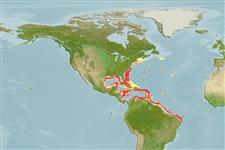Environment: milieu / climate zone / depth range / distribution range
Ecologia
marino batidemersale; distribuzione batimetrica 155 - 1636 m (Ref. 57192), usually 200 - ? m (Ref. 57192). Deep-water; 45°N - 8°S, 98°W - 33°W
Western Atlantic: New England, USA south through the Gulf of Mexico to Campeche, Mexico; off the Central American coast to northern Colombia and northern Brazil; Cuba and St. Kitts.
Size / Peso / Age
Maturity: Lm ? range ? - ? cm
Max length : 10.7 cm SL maschio/sesso non determinato; (Ref. 36347); 9.9 cm SL (female)
Short description
Morfologia | Morfometria
Head small, compressed (19.1-20.1% SL).
Found along the outer continental shelf and slope (Ref. 57192).
Life cycle and mating behavior
Maturità | Riproduzione | Deposizione | Uova | Fecundity | Larve
Munroe, T.A., 2003. Poecilopsettidae. Righteye flounders. p. 1922-1924. In K.E. Carpenter (ed.) FAO species identification guide for fishery purposes. The living marine resources of the Western Central Atlantic. Vol. 3: Bony fishes part 2 (Opistognathidae to Molidae), sea turtles and marine mammals. (Ref. 57192)
IUCN Red List Status (Ref. 130435)
Threat to humans
Harmless
Human uses
Pesca: di nessun interesse
Informazioni ulteriori
Nomi ComuniSinonimiMetabolismoPredatoriEcotossicologiaRiproduzioneMaturitàDeposizioneSpawning aggregationFecundityUovaEgg development
Age/SizeAccrescimentoLength-weightLength-lengthLength-frequenciesMorfometriaMorfologiaLarveDinamica popolazioni larvaliReclutamentoAbbondanzaBRUVS
BibliografiaAcquacolturaProfilo di acquacolturaVarietàGeneticaElectrophoresesEreditarietàMalattieElaborazioneNutrientsMass conversion
CollaboratoriImmaginiStamps, Coins Misc.SuoniCiguateraVelocitàModalità di nuotoArea branchialeOtolithsCervelliVista
Strumenti
Special reports
Download XML
Fonti Internet
Estimates based on models
Preferred temperature (Ref.
123201): 6.2 - 19, mean 11.4 °C (based on 253 cells).
Phylogenetic diversity index (Ref.
82804): PD
50 = 0.5000 [Uniqueness, from 0.5 = low to 2.0 = high].
Bayesian length-weight: a=0.01995 (0.00906 - 0.04395), b=3.01 (2.83 - 3.19), in cm total length, based on all LWR estimates for this body shape (Ref.
93245).
Trophic level (Ref.
69278): 3.4 ±0.4 se; based on size and trophs of closest relatives
Fishing Vulnerability (Ref.
59153): Low vulnerability (10 of 100).
